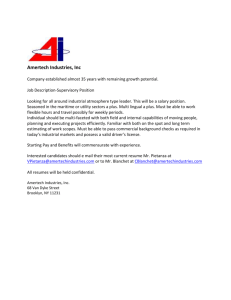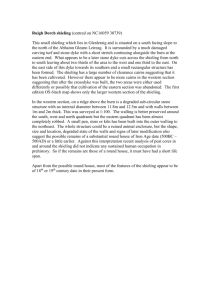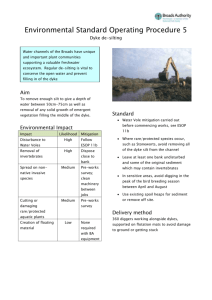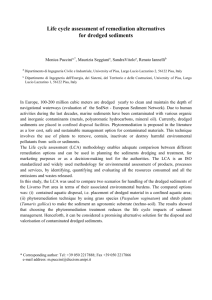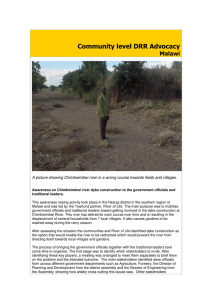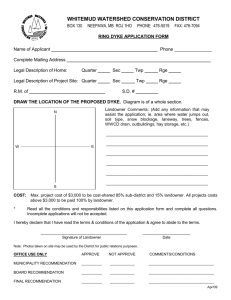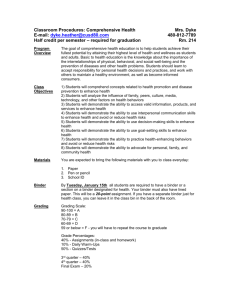THE USE OF ENGINEERED SEDIMENTS FOR DYKE CONSTRUCTION IN THE FLOOD ABSTRACT
advertisement
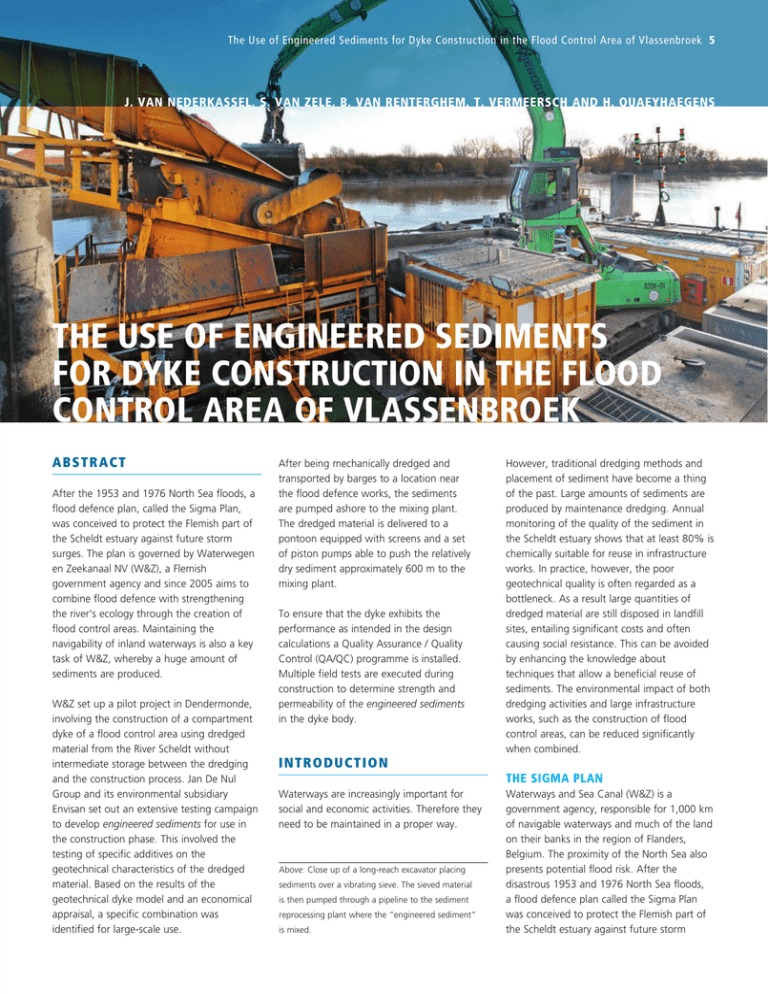
The Use of Engineered Sediments for Dyke Construction in the Flood Control Area of Vlassenbroek 5 J. VAN NEDERKASSEL, S. VAN ZELE, B. VAN RENTERGHEM, T. VERMEERSCH AND H. QUAEYHAEGENS THE USE OF ENGINEERED SEDIMENTS FOR DYKE CONSTRUCTION IN THE FLOOD CONTROL AREA OF VLASSENBROEK AB S T RAC T After the 1953 and 1976 North Sea floods, a flood defence plan, called the Sigma Plan, was conceived to protect the Flemish part of the Scheldt estuary against future storm surges. The plan is governed by Waterwegen en Zeekanaal NV (W&Z), a Flemish government agency and since 2005 aims to combine flood defence with strengthening the river’s ecology through the creation of flood control areas. Maintaining the navigability of inland waterways is also a key task of W&Z, whereby a huge amount of sediments are produced. W&Z set up a pilot project in Dendermonde, involving the construction of a compartment dyke of a flood control area using dredged material from the River Scheldt without intermediate storage between the dredging and the construction process. Jan De Nul Group and its environmental subsidiary Envisan set out an extensive testing campaign to develop engineered sediments for use in the construction phase. This involved the testing of specific additives on the geotechnical characteristics of the dredged material. Based on the results of the geotechnical dyke model and an economical appraisal, a specific combination was identified for large-scale use. After being mechanically dredged and transported by barges to a location near the flood defence works, the sediments are pumped ashore to the mixing plant. The dredged material is delivered to a pontoon equipped with screens and a set of piston pumps able to push the relatively dry sediment approximately 600 m to the mixing plant. To ensure that the dyke exhibits the performance as intended in the design calculations a Quality Assurance / Quality Control (QA/QC) programme is installed. Multiple field tests are executed during construction to determine strength and permeability of the engineered sediments in the dyke body. INTRO DU CT IO N Waterways are increasingly important for social and economic activities. Therefore they need to be maintained in a proper way. Above: Close up of a long-reach excavator placing sediments over a vibrating sieve. The sieved material is then pumped through a pipeline to the sediment reprocessing plant where the “engineered sediment” is mixed. However, traditional dredging methods and placement of sediment have become a thing of the past. Large amounts of sediments are produced by maintenance dredging. Annual monitoring of the quality of the sediment in the Scheldt estuary shows that at least 80% is chemically suitable for reuse in infrastructure works. In practice, however, the poor geotechnical quality is often regarded as a bottleneck. As a result large quantities of dredged material are still disposed in landfill sites, entailing significant costs and often causing social resistance. This can be avoided by enhancing the knowledge about techniques that allow a beneficial reuse of sediments. The environmental impact of both dredging activities and large infrastructure works, such as the construction of flood control areas, can be reduced significantly when combined. THE SIGMA PLAN Waterways and Sea Canal (W&Z) is a government agency, responsible for 1,000 km of navigable waterways and much of the land on their banks in the region of Flanders, Belgium. The proximity of the North Sea also presents potential flood risk. After the disastrous 1953 and 1976 North Sea floods, a flood defence plan called the Sigma Plan was conceived to protect the Flemish part of the Scheldt estuary against future storm 6 Terra et Aqua | Number 138 | March 2015 INNOVATIVE ANSWER Figure 1. Drawing of the location of the Vlassenbroek Flood Control Area (FCA). Insert, map of Belgium; the black dot is Dendermonde. surges. The implementation of the Sigma Plan is one of the key tasks of Waterways and Sea Canal. Since 2005 flood defense is combined with strengthening the river’s ecology through the creation of flood control areas (FCA). To construct new embankments around the first series of flood control areas approximately 2.5 million m³ of construction material is needed. outlined, providing the contractor with non-contaminated sediment with a fine granulometry that lacks the necessary geotechnical characteristics for untreated application in infrastructure works. The overflow dyke, as secondary flood defence structure, was selected to implement the pilot project. FLOOD CONTROL AREA VLASSENBROEK To encourage the innovativeness of the market, W&Z set up a Design/Build project through an open procedure in which the client specifies certain requirements but the contractor is free to pursue unique solutions. In this case, in addition to price, the amount of dredged material being reused and the technical and environmental quality of the bid were assessed in the course of the procurement procedure to select the most economically advantageous tender. The Vlassenbroek polder in Dendermonde is currently being developed into a flood control area (Figure 1). The northern part of this, 102 hectares wide, will be a tidal area with a controlled, reduced tide. With the rhythm of ebb and flow, water will flow into and out of this area via sluices twice a day, creating a unique tidal nature area with mud flats and salt marshes. The southern part of the flood control area, 138 hectares wide, will only flood when extreme storm surges occur (roughly once every 50 years). A typical wetland ecosystem will develop in this area. Both areas are separated from each other by an overflow dyke and surrounded by primary dykes (Figures 2-5). THE VLASSENBROEK PILOT PROJECT Waterways and Sea Canal (W&Z) launched a full-scale pilot project comprising the simultaneous execution of maintenance dredging and dyke construction including 100% reuse of the dredged sediment. The section of the Scheldt to be dredged was Bidders were asked to develop and implement a method to dredge, transport and reuse dredged material to construct the overflow dyke within a framework of strict boundary conditions. The shape of the overflow dyke was prescribed as well as the minimum requirements in relation to the impermeability and micro as well as macro stability. After being dredged the material was to be transported either via the waterway or through pipelines to the construction site for immediate application. Intermediate storage was excluded to minimise the environmental impact of the construction works. In civil construction a widespread technique is to stabilise and solidify soft soils with additives such as lime, fly ash or cement. It is not uncommon that contaminated sediments are stabilised and solidified prior to final disposal in a landfill. Jan De Nul Group came up with the innovative solution to bring the dredged sediments ashore using high density pumps and to create engineered sediments from the soft not-suitable sediments by applying and optimising the stabilisation and solidification methodology.This technology, as applied to the Vlassenbroek pilot project, has the following advantages: - No transport water and associated environmental permitting for water treatment is necessary. - The dyke body can be built up with a high proportion of sediments, minimizing external supply and associated transport. - Workability, shear strength and bearing capacity of the sediments are quickly improved. - Permeability of the sediments is decreased because of physical and chemical binding. - Risk for internal slides is reduced as only one type of dyke material is used. - Internal settlements are reduced as no dewatering takes place and the solidified material gets its final shape in a couple of days to weeks. PILOT PROJECT ACTIVITIES The Vlassenbroek pilot project execution can be divided in four work stages: 1. Design phase 2. Construction phase 3. Quality control 4. Post-construction testing Stage 1: Design Phase Design requirements The overflow dyke has to be 800 m long with 20/4 slopes. Crest width should be 7.0 m wide and 4.5 m above ground level. The total volume of the dyke body is estimated to be 100,000 m³. The design requirements for the overflow dyke are equal to those for a conventional dyke in tidal conditions. The different failure mechanisms (see Figure 6) that have to be addressed are: - Macro stability of the dyke slopes: formation of slip planes between dyke body and subsoil caused by uplifting phenomena. JORIS VAN NEDERKASSEL graduated as a MSc in Bioscience Engineering from Catholic University (KU) Leuven in 2006 and started at Jan De Nul Group as an environmental surveyor in the Middle East and Australia. In 2009 he -M icro stability of the dyke slopes: formation of slip planes in the dyke body caused by infiltrating water. - Piping: erosion of subsoil caused by ground water flow carrying ground particles under dyke body. moved to the Belgian office to follow up on tenders and ongoing projects. In 2011 he became Project Engineer R&D at Envisan, JDN’s environmental subsidiary. SOFIE VAN ZELE graduated in Industrial Engineering, Hogeschool Ghent in 2000 and worked in Stability has to be determined for both the construction phase as well as for the final situation. A minimum safety factor of 1.1 is required for undrained scenarios during construction; for the drained scenario upon completion a minimum safety of 1.3 is required. Figure 2. Vlassenbroek, before flood control works. Ireland on remediation projects. She joined the Jan De Nul Group in 2011 in the Environmental Dredging Division and was project manager during the construction of the Moen sediment treatment centre and the compartment dyke in Vlassenbroek, where she now manages the dyke construction. BRAM VAN RENTERGHEM obtained an MSc in Bioscience Engineering and in Environmental Remediation and Management from University of Ghent in 2004. In 2006 he joined the Jan De Nul Group as an environmental engineer and since 2008 is an operational dredging superintendent. He was outsourced for 3 Boundary conditions for the stability as well as permeability of the overflow dyke are governed by normative water levels that might occur in the flood control area of Vlassenbroek during storm events (see Figure 7). One of the storm events that has to be addressed for the calculation is the unlikely event in which the reduced tidal area is operating normally (water can flow in and out through the sluices connected with Scheldt) and the controlled flooding area has continuously high water for 7 consecutive days (outgoing sluice is closed). Settlement at the location of the overflow dyke had to be checked and incorporated in the design. Figure 3. Flood Control Area (FCA) at high tide. years to Envisan as a Project Manager and as such followed up at Vlassenbroek. TOM VERMEERSCH graduated in 2009 with a MSc in Civil Engineering from the University of Ghent and joined the Design and Engineering Department of the Jan De Nul Group. He has worked as Design Engineer on civil and Stability calculations The flow scheme shown in Figure 8 is followed during the design calculations. Stability calculations are performed with SLOPE/W software and seepage modelling is performed with SEEP/W. Input parameters for subsoil and dyke material are gathered from laboratory and field investigations. dredging projects such as the Ivoz-Ramet Lock and flood control dykes in Vlassen­ broek and the tender for the Fehmarnbelt Tunnel between Denmark and Germany. HANS QUAEYHAEGENS obtained an MSc in Bio Engineering at the University of Louvain, Belgium in 2004 and then worked as a project manager on The results of the transient seepage modelling show that the water flow in the overflow dyke is negligible in all scenarios. For example, in the worst case event with seven days of continuous high water in the controlled tidal area and the controlled flooding area empty, the water flow in the overflow dyke is 1.49E-07 m³/s/m dyke. environmental remediation projects in Belgium and France. In 2007 he joined the Flemish government agency Waterwegen & Zeekanaal as project engineer on projects that are part of the Sigma Plan, the Flemish flood protection programme. The modelled water table is subsequently used in the stability calculations to determine the critical circular and non-circular failure mechanisms via the Bishop method. Given the fact that a 3.5-m wide service road will be Figure 4. FCA at storm tide. Figure 5. FCA at extreme storm tide. 8 Terra et Aqua | Number 138 | March 2015 Slip plane at GGG side Slip plane at GOG side Micro(in)stability Piping Figure 6. Four different failure mechanisms addressed in the design. constructed on the crest of the overflow dyke, a traffic load of 15 kN/m² on top of the dyke was taken into account in the calculations. After the last construction stage, a minimum safety factor of 2.08 is calculated (Figure 9). For the completed dyke, under highest water conditions, a minimum safety factor of 1.36 against circular and non-circular failure mechanisms at the controlled flooding area side is obtained (Figure 10). Another important consideration in the design is the stability analysis during rapid drawdown. The stabilising effect of the water on the reduced tidal area side is then lost, but the pore-water pressures within the dyke may remain present for a certain period. This can have a negative effect on the stability of dyke slope at the reduced tidal area side. For the overflow dyke, the rapid drawdown calculation gives a safety factor of 1.91. All calculated safety factors are higher than the minimum design requirements. Another failure mechanism that is addressed is piping. Piping can induce dyke sagging and finally lead to slope failure. The method of Sellmeijer is used and takes into account the granulometry and permeability of the waterbearing soil layer. The result show that the calculated critical water level difference from which piping can be expected (16.6 m) is much higher than the maximum water level of 5.0 m that can occur. Settlements in the subsoil are calculated using Sanglerat’s method. Subsoil parameters are obtained from CPT soundings. Density of the dyke material is set to 16.5 kN/m³. Settlement of the subsoil is estimated to be 16 cm. Given the sandy nature of the dyke material no significant settlements in the dyke material itself are expected. Preparatory site investigation To gain insight into the sediment and subsoil quality, a preparatory investigation of these materials is essential. Extensive sediment sampling over the 2.5-km-long section to be dredged on the Scheldt is performed. During the fieldwork, the regulatory guidelines, in the form of codes of good practice, are followed. The results of the geotechnical investigation are summarised in Table I and Figure 11. From a geotechnical point of view the in-situ sediment has a fine sandy loam texture that lacks the necessary geotechnical characteristics for untreated application in infrastructure works. For that purpose, the sediments should be dewatered and/or strengthened. The sediment is non-contaminated and can be reused as construction material under the Flemish legal framework for reuse of waste materials. A detailed identification of the subsoil is a vital element in the proper understanding of the geotechnical characteristics of the material at the construction area. Therefore, multiple boreholes were drilled up to 15 m deep in the subsoil. At each location a minimum of five undisturbed samples were taken equally spread over the drilled profile. Figure 7. Example of water level variations checked in the design. Tests and analyses that were performed on these samples include: particle size distribution, soil consistency/water content, organic content, settlement and consolidation characteristics via the oedometer test and determination of shear strength characteristics using the laboratory vane apparatus. These The Use of Engineered Sediments for Dyke Construction in the Flood Control Area of Vlassenbroek 9 data were supplemented with field tests such as cone penetration testing (CPT) and hand vane tests. Based on the soil survey, a stratification is produced over the entire dyke section (see Figure 12) and the necessary calculation parameters for the stability calculations are determined. development. In a second step a more in-depth testing procedure is followed to come down to the most suitable additive(s) results with regard to strength and permeability. The laboratory investigations are checked with the stability calculations and further optimised (Figure 13). Engineered sediments To improve the geotechnical properties of the dredged sediment, the material has to be amended with suitable additives. A wide range of additives is available including hydraulic and pouzzolane binders. Owing to environmental, geotechnical and economical restriction, however, only a few are suitable. In an extensive laboratory study various types and combinations of additives are mixed with the sediments and strength and permeability of the mixtures are analysed. From the stability calculations it became clear that the minimum strength and maximum permeability requirements for the dyke material are as in Table II. From an operational point of view (bearing of earth-moving equipment) these values must be met after a few days. The quick screening procedure focused on the strength development in function of four key parameters: - type of additives - dose of additives - influence of water content - hardening time In a first step, a quick screening procedure is drawn up to select the additives with promising results with regard to strength Figure 9. Safety factor for critical slip surfaces at controlled flooding area side during construction (undrained calculation). Figure 10. Safety factor for critical slip surfaces at controlled flooding area side during high water levels (drained calculation). Tested additives include: cements, quick lime, fly ashes, bottom ashes, granulated blast furnace slags and sodium silicate. Besides geotechnical properties also correct certification and cost effectiveness were taken into account as a decision factor in additive selection. In the laboratory tests specimens are obtained by mixing the sediments and additives to a homogenous mass. These mixtures are stored in air-tight plastic recipients. After 7, 14 and 28 days hardening, the undrained shear strength of the mixtures is determined using the motorised laboratory vane apparatus (Figure 14). Determine geometry and water level Figure 8. Flow chart for the dyke design. Soil study: Soil composition, foreland, hinterland Determine seepage line, leak length and seepage length Evaluation observations Piping sensitive composition? Heave diagram Heave or piping Piping diagram 10 Terra et Aqua | Number 138 | March 2015 Clay (< 2 µm) Table I. Results of the geotechnical investigation. Parameter Figure 11. Average geotechnical characteristics of the dredged Value Unit Dry matter (DM) content 65.8 % Water content 52.3 % Density 1.65 ton/m³ Organic Matter 3.7 % DM sand (63µm - 2mm) 61.5 % silt (2µm - 63µm) 24.4 % clay (<2µm) 14.1 % Plasticity index (Ip) 11.5 material. Sandy loam Particle size distribution Undrained shear strength (cu) 0 kPa Table II. Required design properties for engineered sediments. Parameter Value Unit Cohesion c 4 kPa Angle of friction φ 25 ° Undrained shear strength cu 35 kPa 1.0E-07 m/s Water permeability k Figure 15 shows for a range of additives the dose in function of the water content to obtain the required 35 kPa undrained shear strength. It is clear that the water content and additive dose play an important role. Also the exact composition of the additive mix has an important effect on the developed strength. This is also shown in Figure 15 where the hydraulic binder (cement) in additive blends 1 and 2 is the same, but where the type of pouzzolane (two different types of fly ashes) is altered. 0 10 20 30 40 50 60 Sand (2000-63µm) in function of the additive dose and the hardening time for sediments with a typical water content of 52%. Observations show that a threshold exist after which the strength starts to increase exponentially. Follow-up of the strength until 91 days shows that 95-99% of the maximum strength is reached after 28 days. In a last step, CU tri-axial tests and permeability tests are performed in an accredited laboratory on engineered sediments prepared with the optimal dose of the best performing additive. CU tri-axial test are performed according to British Standard BS 1377-8. Saturation of the samples is conducted at a back pressure of 300 kPa. Consolidation is executed at 50, 75 and 80 90 100 Loam (63-2µm) 100 kPa. In a last step, an anisotropic load is applied to the samples until failure. Cohesion and internal angle of friction are determined by plotting the corresponding Mohr’s circles of effective stress. Cohesion varies between 5 and 8 kPa and internal angle of friction between 35 and 39 degrees. Both geotechnical parameters meet the minimum requirements set out in the stability calculations. Permeability tests are performed according to Standard ISO 17892-11. Samples are first saturated by applying a hydrostatic back pressure of 300 kPa and are then tested at a relevant stress level of 50 kPa. The hydraulic conductivity for the optimal mixtures varies Based on the quick screening results, a blend of Portland cement and fly ashes with high reactive silica content is selected as the best performing additive. In a next step the dose of this additive is optimised with regard to strength and permeability. The engineered sediments should develop sufficient strength after one week to support heavy earth moving machinery. The permeability should be no higher than the required 1.0E-07 m/s. Figure 16 shows the evolution of the strength 70 Figure 12. Stratification of the subsoil at the construction area. The Use of Engineered Sediments for Dyke Construction in the Flood Control Area of Vlassenbroek 11 between 6.3E-09 and 3.6E-08 m/s, which is well below the required 1.0E-07 m/s. Figure 13. Flow scheme of Sediment sampling Stage 2: Construction Phase Depending on the type of material, overall unloading capacity is between 80 and 130 m³ per operational hour. Each high density pump is connected to a 580 m long 250 mm diameter pipeline. This pipeline is conceived to withstand pressures of up to 80 bar. Mixing unit Once pushed through the pipeline, the sediments arrive in the mixing unit (Figure 18). The mixing takes place in two parallel continuous ploughshare mixers which create a continuous whirling in the mixing chamber. The incoming volumetric flow of sediments is measured and the dosing of additives from a silo is adjusted to this flow by means of calibrated frequency driven dozing screws. When the mixture reaches the outlet of the continuous mixer it is transformed into a homogenous mass. These engineered sediments fall into 45 m³ hoppers before being loaded into Volvo A25 dump trucks and transported towards the dyke construction area. Sediment characterisation Additive(s) selection: Available hydraulic binders 1 st optimisation Mixing of additives and sediment Preparation of test specimen Hardening for 7, 14, 21 days Undrained Shear Strength Drained Strength Permeability Stability calculations Optimal additive type and dose place and as soon as they reach their desired strength an excavator again creates small temporary bunds, but this time from the hardened engineered sediments. A sub­ sequent layer of engineered sediments can be placed on top of the first layer (Figure 20). The same methodology is applied for the subsequent layers (Figure 21) until the design height of the overflow dyke is reached. Once the overflow dyke has reached the design height and strength the raised dyke is profiled using a low-impact Caterpillar D5 bull dozer, equipped with GPS instrumentation (Figure 22). Vegetation cover In order to protect the slopes of the newly Dyke construction At the dyke footprint, a 0.5-m-thick turf layer is stripped first. Two temporary bunds are built with the excavated material (Figure 19). A first layer of engineered sediments is then spread between these bunds. The engineered sediments start hardening in 2 nd optimisation Unloading platform The sediments are dredged using a backhoe dredger and transported by elevator barges to the unloading area. The unloading platform is designed to unload, screen and transport sediment delivered by barges (Figure 17). The unloading is done by a long reach transshipment crane, mounted on a pontoon. The crane discharges the sediment into a vibrating screen with mesh which extracts the large debris. After passing the screen, the sediment arrives in a dispenser which feeds the sediment to two high density pumps. The latter push the sediment into pipelines towards the mixing unit. The high density pumps are driven by hydraulic aggregates, which are mounted on the pontoon. testing procedure. Figure 14. Engineered sediments during hardening and the laboratory vane apparatus. 12 Terra et Aqua | Number 138 | March 2015 Additive dose (% on wet weight) 16% additive 1: target 35 kPa constructed overflow dyke against erosion caused by rainfall and to integrate the dyke into the landscape, a vegetation cover on the dyke slopes was installed. A hand-seeding experiment led to the conclusion that a classic-sowing technique, in which the dyke surface is roughened, seeded and finally rolled, would not result in a fast sprout of the grass seeds. Dry weather conditions and harsh subsoil characteristics such as low permeability and high alkalinity prevent fast germination. additive 2: target 35 kPa 14% other additives: target 35 kPa 12% 10% 8% 6% 4% 2% 40 60 80 100 140 120 160 Water content (%) Figure 15. Additive dose in function of water content for different additive blends. 200 3.6% 4.8% 6.0% 7.2% 9.1 % dose on wet weight 180 Shear strength (kPa) 160 140 120 100 80 60 Stage 3: Quality Control 40 20 0 Therefore, sowing of around 35,000 m² of dyke slopes was realised by hydro-seeding. The seed mixture dosed at 300 kg/ha is mixed with water, an acidifier, mulch and binders. By using a binder based on starch, the seed sticks to the dyke slopes. Another polymer serves as a water retaining agent, while the mulch improves the fertility of the surface. Figure 23 shows the completed overflow dyke with the realised vegetation cover. 0 7 14 21 28 Hardening time (days) Figure 16. Shear strength in function of dose and hardening time. Horizontal line indicates minimum required strength. The main purpose of the quality assurance and quality control (QA/QC) is to ensure that the design requirements are met throughout the execution of the project. The QA/QC plan accounts for the quality of the incoming materials and processes as well as the performance criteria of the engineered sediments considering the boundary conditions of the project. Process monitoring The preparatory investigations revealed that the geotechnical quality of the dredged sediments can influence certain process parameters such as pumpability of the material, and accuracy of additive dosing and mixing. Figure 17. A specially designed discharge pier accommodates the high tidal amplitude and strong currents at Figure 18. Sediment-additive mixing unit where the the site. A long-reach excavator unloads sediments from a barge and places them over a vibrating sieve. sediments are ‘engineered’. The high-density, sieved material is then pushed through a pipeline towards the mixing unit. The Use of Engineered Sediments for Dyke Construction in the Flood Control Area of Vlassenbroek 13 Although the preparatory site investigation also reveals that heterogeneity in the dredged sediments is limited, the decision was taken to regularly check geotechnical quality of the dredged sediments. In the case that the analytical results show a deviation in sediment characteristics, anticipative actions can be taken by adjusting the relevant process parameters. Figure 19. Construction of temporary bunds from stripped turf layer. Representative material samples are taken from every barge arriving at the unloading platform and checked in the laboratory for dry matter content, particle size distribution and organic matter content. Material testing during the works confirms the findings of the preparatory investigations: dredged sediment heterogeneity is limited and process parameters are hardly influenced. Figure 20. Construction of first layer Engineered Sediments and temporary bunds. Performance testing The most relevant aspect to be monitored is the stability of the dyke material. Therefore procedures are drawn for testing the strength and permeability of the dyke material. A quick way to determine strength characteristics of the engineered sediments in the field is measuring the undrained shear strength by means of the hand vane tester (Figure 24). During the works the vane shear strength is measured after placement of each layer engineered sediments in the dyke profile. Measurements are done on a uniform grid of 20 x 20 m. At each grid point measurements are done at the surface and at every metre in vertical direction. Vane shear results are corrected for plasticity, anisotropy and rate effects according to the formula of Bjerrum (Van ’t Hoff and van der Kolff 2012). Field vane tests show that the average undrained shear strength was 76 ± 29 kPa at the surface and 55 ± 20 kPa in the depth. The higher strengths at the surface may be explained by natural drying and compacting of dyke material by earth moving machinery. To validate the field tests, undisturbed samples are taken to determine the cohesion and angle of friction by means of CU tri-axial testing in an accredited laboratory. The cohesion varies between 8 and 30 kPa and the angle of friction between 34 and 40 degrees. The variation in cohesion is Figure 21. Construction of subsequent layers of Engineered Sediments and temporary bunds. Figure 22. Profiled overflow dyke. Table III. Comparison of strength parameters in different phases of the project. Design requirements Preparatory investigation Quality control execution phase Shear strength 35 kPa 33-44 kPa 55 ± 20 kPa Cohesion 4 kPa 5-8 kPa 8-30 kPa 25˚ 35-39˚ 33-40˚ Design parameter Angle of friction Table IV. Comparison of permeability measured in different phases of the project. Design parameter Permeability Design requirements 1.0E-07 m/s Preparatory investigation Quality control execution phase 3.6E-08 - 6.3E-09 m/s 8.3E-08 - 1.6E-09 m/s well below the maximum requirement set out in the stability calculations (see Table IV). Stage 4: Post-Construction Testing Three months after completing the construction of the dyke a test programme was started to check whether the overflow dyke meets the contractual requirements. The programme involves cone penetration testing and borehole drilling followed by laboratory testing. Figure 23. The completed overflow dyke in autumn 2013, covered with vegetation for protection against erosion. associated with that in undrained shear strength. The quality control results show that the strength of the engineered sediments is well above the minimum requirements set out in the stability calculations (see Table III). The double ring infiltrometer is a simple instrument to measure the vertical permeability of the dyke material (Figure 25). Two rings are partially inserted into the dyke material and filled with water, after which the drop in the water level during a certain time interval is measured. Measurements are according to the ASTM D3385-03 standard test method. Field permeability ranges from 1.0E-08 to 8.3E-08 m/s. To validate the field tests, undisturbed samples are taken to determine the permeability in an accredited laboratory. The quality control results show that the permeability of the engineered sediments is Cone Penetration Test A good in-situ technique to check the homogeneity of the dyke material is cone penetration testing (CPT). This test has the advantage of providing an immediate continuous profile. Soundings are conducted with a hydraulic 200 kN-penetrometer mounted on a crawler. Cone-tip resistance (qc) and cone-tip friction (fs) are recorded every 2 cm over 7 metres depth. Soundings are carried out every 50 m across the dyke crest. A typical CPT result is shown in Figure 26. The peak in cone tip resistance in the upper 0.5 m can be ascribed to a gravel road that is build up on top of the dyke. Underneath the conetip resistance drops to around 500-700 kPa and stays in this range for 3 to 4 metres. This indicates a good homogeneity of the engineered sediments layer. The increase in strength around 5 metres is associated with the subsoil on which the overflow dyke is placed. The undrained shear strength cu can be derived from the cone tip resistance (Burgos et al. 2007; Van ’t Hoff and van der Kolff 2012). A frequently used correlation to derive cu from a CPT measurement is: cu = Figure 25. Double ring infiltrometer for permeability Figure 24. Hand vane for shear strength testing. testing. qc Nc Where Nc is an empirical factor that usually varies between 10 and 15. This correlation is calibrated by vane shear tests on undisturbed soil samples taken during the postconstruction phase testing programme. In this case, Nc = 13.5 has been adopted. The stability calculations require the dyke material to have a minimal undrained shear strength of 35 kPa, which corresponds to a cone tip resistance of 473 kPa. Figure 27 shows the median of the values for each depth. The Use of Engineered Sediments for Dyke Construction in the Flood Control Area of Vlassenbroek 15 qc (kPa) qc (kPa) 5000 10000 15000 20000 0 1 1 2 2 depth (m bgl) depth (m bgl) 0 0 3 4 0 1000 2000 3000 Figure 26. (left) Typical cone tip construction CPT tests. Figure 27. (right) Average cone tip resistance versus required values. 4 5 6 6 7 7 minimal required median performed and at 4, depths samples are taken from the dyke material. Table V shows the results for the strength and permeability parameters. The vertical permeability is well Table V. Post construction testing results. below the maximum requirement set out in the stability study. Two cu tri-axial test values indicate insufficient strength, but the cohesion and cu measured with the lab vane apparatus at all depths do meet the requirements. EXTENSION GRANTED Depth (m bgl) c Tri-axial test (kPa) cu Tri-axial test cu Lab vane test (kPa) (kPa) 1.00 – 1.50 17.0 102.8 54.9 5.83E-09 1.75 – 2.25 6.5 31.6 56.7 3.46E-08 2.50 – 3.00 5.2 23.3 39.2 2.19E-08 3.25 – 3.72 9.3 37.7 54.2 5.26E-09 Figure 28. Vlassenbroek primary flood defence dyke construction site. 5000 resistance measurement in post- 3 5 Boring samples Five sampling locations are chosen on top of the overflow dyke crest. At each of these locations, drillings up to 5 m deep are 4000 Permeability (m/s) In February 2014 Jan De Nul Group was granted an extension to the contract. The principal – Waterways and Sea Canal – asked the JDN Group to apply the same technologies to construct a primary flood defence dyke close to the village centre of Vlassenbroek (Figure 28). This 700-m long and 6-m high primary dyke will protect the village from the water that flows into the flood 16 Terra et Aqua | Number 138 | March 2015 control area. The dyke will be built with dredged material of similar environmental and geotechnical quality. A small-scale laboratory investigation validated the results of the extensive stabilisation tests performed in the design phase for the construction of the overflow dyke. As such, the same blend of additives will be used to enhance the quality of the sediments. After successfully completing the preparatory works (site investigation, lab testing and stability calculations) the execution works started in august 2014. Lessons learnt during the first pilot project are currently being usefully applied on the extension project which makes that the project runs on schedule and is expected to be completed in summer 2015. RE F E RE N C E S Boubaker, R. and Boutouil, M. (2009). Organic matter and cement content effect of geotechnical properties of cement treated sediments. I2SM Conference, Lille, France. Boutouil, M. (1999). Traitement des vases de dragage par solidification/stabilisation à base de ciment et additifs. Ph.D thesis. Caen University, France, 276 p. Burgos, M., Samper, F. and Alonso, JJ. (2007). “Improvements carried out in very soft dredged mud soil in the Port of Valencia (Spain)”. European Conference on Soil Mechanics and Geotechnical Engineering, 2091-2104. CO NCL U S IO NS The full-scale Vlassenbroek pilot project comprises the simultaneous execution of maintenance dredging and dyke construction including 100% reuse of the dredged sediment. By combining these works greater efficiency could be gained. Beneficial reuse of sediments avoids disposing large quantities of material in landfill sites, entailing important costs and often causing social resistance. Additional efficiency gains could be obtained by applying an innovative work methodology which encompassed dredging, transporting, processing and reusing the dredged material as engineered sediments to construct the overflow dyke. By optimally planning and adjusting this sequence of activities considerable savings in time, space and cost could be achieved: - On time delivery of dredged sediments reduced idle time of the onshore part of the operational chain. Transport of the dredged material took place over water which saved thousands of truck transports by road. High tidal ranges and currents were addressed. CASST (2004). “Review of scientific literature on the use of stabilisation/solidification for the treatment of contaminated soil, solid waste and sludges”. www.environment-agency.gov.uk Geotechniek (2013). GEO-13/44 “Verslag over de resultaten van vijf boringen met bijhorend laboratoriumonderzoek uitgevoerd ter controle van de aangelegde compartimen­ teringsdijk in het overstromingsgebied (GOG en GGG) langs de rechteroever van de Schelde in Dendermonde (Vlassenbroek)”. Expertise Netwerk Waterkeren. (2007). “Technisch Rapport Ontwerpbelastingen voor het rivierengebied. 06 Faalmechanismen en de hydraulische belastingen”. SMOCS (2012). “Report on sustainable management of Contaminated Sediments: Review of Potential Applications for s/s”. http://www.smocs.eu. Geotechniek (2013). GEO-13/43 “Verslag over de resultaten van de sonderingen uitgevoerd voor de controle van de aangelegde compartimenteringsdijk in het G.O.G. in Dendermonde (Vlassenbroek)”. Swedish Geotechnical Institute (2006). “Report 72 on Strength of stabilised soils – A laboratory study on clays and organic soils stabilised with different types of binder”. http://www.swedgeo.se/upload/publikationer. - D redging and pumping the sediments at in-situ density eliminates a dewatering step, as such intermediate storage could be excluded and environmental impacts limited. - After processing the sediments in the mixing unit the material was immediately applied at its final location in the construction works. No external supply of dyke material was needed. Laboratory testing followed by full-scale field trials demonstrated that the requirements in terms of stability and permeability could be achieved. The use of high-density pumps and a well-controlled processing plant eliminated the need for rehandling and intermediate storage of the solidified material. The applied technique opens the door for a new approach in the application of fine sediments in large scale infrastructure works. By effective selection of additive and application dose, unsuitable sediments are turned into useful construction material within days and with a minimum handling at a cost effect rate. Technical Advisory Committee on Flood Defences (1999). Technical Report on Sand Boils (piping). University of Ghent, Belgium (2013). “Report XI.13.10. Laboratory and in situ hydraulic conductivity tests of an embankment of amended dredged sediments”. Van ‘t Hoff, J. and van der Kolff, A.N. (2012). Hydraulic Fill Manual: For Dredging and Reclamation Works. CRC Press. 642 p. Waterwegen en Zeekanaal NV (2014). “Projectbrochure Vlassenbroek editie 2014”. http://www.sigmaplan.be.
